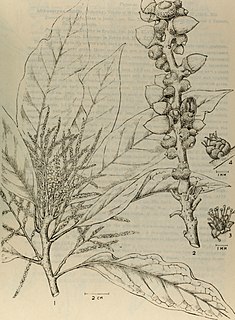Canarium patentinervium is a tree of tropical Asia in the incense tree family Burseraceae. The specific epithet patentinervium is from the Latin meaning "spreading nerves", referring to the leaf veins.
Helicia attenuata is a plant in the family Proteaceae. The specific epithet attenuata means "drawn out", referring to the leaf base.
Helicia maxwelliana is a plant in the family Proteaceae. It grows as a treelet up to 3 metres (10 ft) tall. The twigs are dark brown. The flowers are reddish brown. The fruit is black, round, up to 2.5 centimetres (1 in) in diameter. Its habitat is montane forest at 1,600 metres (5,200 ft) to 1,700 metres (5,600 ft) altitude. H. maxwelliana is endemic to Borneo.
Helicia pterygota is a plant in the family Proteaceae. It grows as a shrub or small tree up to 7 metres (20 ft) tall, with a stem diameter of up to 6 centimetres (2 in). The bark is brownish. The specific epithet pterygota is from the Greek meaning "winged", referring to the pedicel. Habitat is forests from 1,000 metres (3,300 ft) to 1,800 metres (6,000 ft) altitude. H. pterygota is endemic to Borneo where it is confined to Mount Kinabalu in Sabah.
Heliciopsis velutina is a species of trees, in the family Proteaceae. They grow up to 25 metres (80 ft) tall, with a trunk diameter of up to 25 cm (10 in). The bark is dark brown. They have reddish brown flowers. They have brown, ellipsoid fruits up to 4 cm (2 in) long. The specific epithet velutina comes from the Latin meaning "velvety", referring to the petiole. They grow naturally in lowland mixed dipterocarp forests' habitats from sea level to 600 metres (2,000 ft) altitude in Peninsular Malaysia and Borneo.
Chisocheton granatum is a tree in the family Meliaceae. The specific epithet granatum is from the Latin meaning "pomegranate", referring to the shape of the fruit.
Chisocheton patens is a tree in the family Meliaceae. The specific epithet patens is from the Latin meaning "spreading", referring to the inflorescence.
Dysoxylum cauliflorum is a tree in the family Meliaceae. The specific epithet cauliflorum is from the Latin meaning "flowers on the trunk".
Dysoxylum oppositifolium is a tree in the family Meliaceae. The specific epithet oppositifolium is from the Latin meaning "opposite leaf", referring to the leaves being on opposite sides of the stem.
Dysoxylum papillosum is a tree in the family Meliaceae. The specific epithet papillosum is from the Latin meaning "pimpled", referring to the leaf surface when dry.
Dysoxylum arborescens is a tree in the family Meliaceae. The specific epithet arborescens is from the Latin meaning "tree-like".
Xanthophyllum trichocladum is a plant in the family Polygalaceae. The specific epithet trichocladum is from the Greek meaning "hairy twig".
Canarium apertum is a tree in the family Burseraceae. The specific epithet apertum is from the Latin meaning "open", referring to the basal openings between petals.
Dacryodes longifolia is a tree in the family Burseraceae. The specific epithet longifolia is from the Latin meaning "long leaf".
Clethra canescens var. clementis is a tree in the family Clethraceae.
Clethra pachyphylla is a tree in the family Clethraceae. The specific epithet pachyphylla is from the Greek meaning "thick leaves".
Melicope denhamii is a plant in the family Rutaceae. It is named for the 19th century Royal Navy captain Henry Mangles Denham.
Bruinsmia styracoides is a large tree of tropical Asia in the family Styracaceae. The specific epithet styracoides refers to the tree's resemblance to Styrax officinalis.
Buchanania insignis is a tree of Borneo in the cashew and sumac family Anacardiaceae. The specific epithet insignis is from the Latin meaning "remarkable".

Lithocarpus elegans is a tree in the beech family Fagaceae. The specific epithet elegans is from the Latin meaning "elegant", referring to the acorns and cupules.
